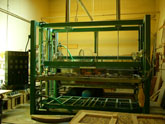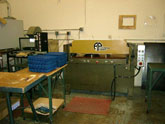
Thermoforming Design Guidelines
Vacuum and pressure thermoforming for the purpose of this discussion is to be
considered a single sheet of “heavy gauge” (.060”+ thickness) thermoplastic, which is
held in a rectangular or square platen, heated in a oven to an optimum forming
temperature, then formed over a single sided tool. This tool is usually aluminum for
production runs and would include vacuum holes and enclosure to facilitate pulling the
part down on the tool. Pressure may be applied to the side opposite the tool, possibly
along with a plug assist to enhance certain features for cosmetic, close tolerance parts.
Rough layout of the part should be square or rectangular to minimize scrap.
As thermoforming is a done with a single sided tool, the critical surface of the part
should always face the tool as this is the “controlled” surface with the best tolerances
and surface treatment. Features formed on the controlled side of the part will telegraph
through to the back side and vice verse. General guidelines for part design are as follows,
although ATI is often capable of bending these rules in certain circumstances.
1) Draft: Draft is the degree of taper of a vertical sidewall to facilitate removal of
the part from the tool. Always provide the maximum draft possible for any given
vertical feature, as this can help minimize de-molding problems and may help
reduce part cost. 1.5-2º of draft is a minimum on a female feature, and a deep
texture will require more. For male features, minimums are in the 4-6º range.
The deeper the feature or rougher the surface texture, the more draft is required.
a. It is possible, given certain geometries, to have 0º draft on female vertical
walls
2) Radii: The greater the radii the better from the perspective of material
distribution (and therefore cost). Tight radii in the range of .015” can be attained
in a female pressure-formed part. Over a male feature, the thickness of the
material plus .030-.060” is desirable. Related to radii is the intersection of
adjoining surfaces. Try to avoid joining outside or inside surfaces at less than 90’..
3) Draw Ratio: The draw ratio expresses the relationship between the beginning
surface area of the unformed sheet which covers the opening of a feature, and the
ending surface area of the interior of the feature once formed formed. A 3 to 1
ratio is generally a maximum draw ratio. Avoid multiple tall features too close to
each other. Generally, the distance between two features, like ribs or cooling
vents, needs to be no less than 2x the material thickness.
4) Under cuts: Undercuts are features protruding from or into the tool surface,
which would prevent removal of the part from the tool. Such features are possible
with the use of movable “cores-pulls” in the tool, which are often automatic.
These cores are used to form the feature, then are retracted to allow the part to be
removed. Under cuts are generally not to exceed 5/8” in depth.
5) Reference Points: Reference points should be designed into a part, which allows
a measurement from a controlled (molded) surface or point to a critical feature of
the part, such as drilled hole centers, cutouts, or other features.
6) Ribs and Bosses: Ribs may be formed into the part according to the parameters
above. Ribs are used to support a flat surface. Ribs or other reinforcement may
also be machined independently and glued in at added cost. Internal bosses may
also be independently machined and glued in, roughly at a cost of $2 per boss.
7) Texture: Texture may be incorporated into a given part either by using a textured
raw material or by texturing the face of the tool.. Texturing is of course an added
expense and requires increased draft. More than one texture can be done on a
part, as can areas of no texture.
8) Joining Lines: Two parts may be joined together such as a front and back case.
The preferred joint is a lap joint, which would form an under cut in one of the
parts adding expense to the tool. The joint should also require a witness line of
about .060” to accommodate tolerance variation of the joint.
9) Trim, Holes, Cut-Outs, Vents: Trimming dimensions need to be referenced
from the molded side of the part. Vents, or openings may be molded in by the use
of a male feature, and then machined off from the back to give a finished outside
edge where hardware or electronics are mounted from the inside to show through
to the exterior.
10) Hardware: All manner of hardware can be attached in secondary operations.
And oftentimes hardware can be “insert-molded” into the part.
11) Tolerances: Tolerances are a variable, which ranges from the thickness and
surface of the extruded stock, through tooling, trim and precision routing. Always
provide the greatest tolerance possible to reduce costs and lead-time.
- Formed details are +/-.030” up to 12”, plus .002” per inch ;
- Drilled hole centers are +/-.015” up to 12”, plus .001” per
inch above 12”;
- Trim dimensions are+/-.030” up to 12” plus .002” per inch above 12”
Please note, exceptions to the above guidelines can always be entertained.
Typical Thermoforming Problems
Thermoform Process and Features
Dimensional Tolerances
Formech Vacuum Guide
Impax 452 Material Specifications
Royalite







